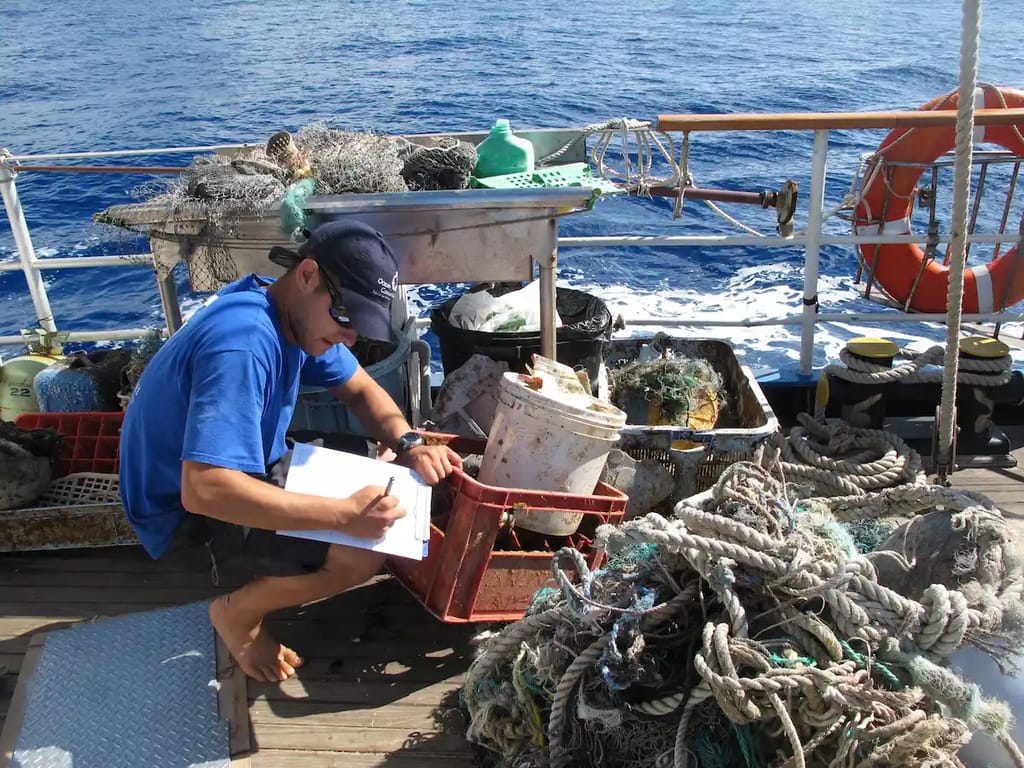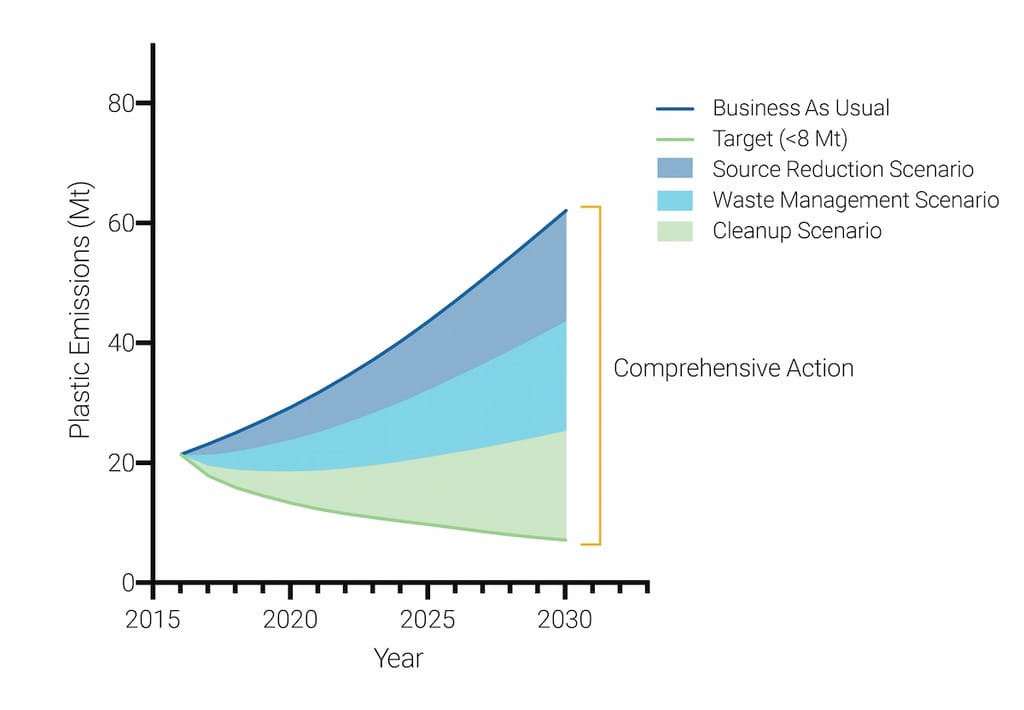How Do We Solve the Plastic Pollution Crisis? Three (Not-So-Easy, but Straightforward) Steps
Reflecting on what we’ve learned in the 50 years since discovering the Great Pacific Garbage Patch

In early 1973, a group of scientists published an article in the journal Nature reflecting on a research expedition they had taken the year before, in an area of the Pacific Ocean some 600 miles from Hawaii known as the North Pacific Gyre. During “their leisure time on the bow of the ship,” they had noticed that “the sea surface is littered with a startling array of man-made objects,” and they began casually logging their findings—54 items in total, 28 of which were plastic bottles or fragments.
Get Ocean Updates in Your Inbox
Sign up with your email and never miss an update.
They went on to estimate that there must be five million plastic bottles floating in the Pacific Ocean and, while suspecting that “the inert nature of plastic means that it is unlikely to enter the food chain and threaten human welfare,” lamented that “unless we find adequate means of disposing of our plastic products soon, we can anticipate that the ‘Wynkin, Blynkin and Nod’ of our children will set sail into a plastic sea.”
Having spent time in this area (more commonly known as the Great Pacific Garbage Patch) back in 2010 and seen with my own eyes the seemingly countless numbers of plastics now polluting the gyre, I can’t help but think about the incredible growth in our scientific understanding of the plastic pollution crisis—not only since this article came out 50 years ago, but even in the past decade.

To put their plastic bottle estimate into perspective, volunteers with Ocean Conservancy’s International Coastal Cleanup® collect approximately one million bottles from beaches and waterways in just a single day each year. It is now well established that tiny plastic fragments—or microplastics—have entered the food chain, and are showing up everywhere scientists have looked, including our own bodies. And while we absolutely do need to find “adequate means of disposing of our plastic products” to avoid a plastic-sea scenario, we know that alone won’t do the trick.
In fact, that’s probably what strikes me the most. We know exactly what it will take to address plastic pollution, thanks to a number of studies, including one, published in 2020, that I co-authored with colleagues in the journal Science. It’s a simple recipe, with three ingredients:
Reduce. Cutting the amount of plastics—especially single-use plastics—that we produce is foundational to solving the plastic pollution crisis. Currently, 11 million metric tons (MMT)of mostly single-use items enter the ocean each year solely from land-based sources. That’s more than a garbage truck’s worth of plastics every minute, and the figure is expected to triple by 2040 if we continue producing and using plastics the way we are now. Every model scientists have come up with to figure out how to curb plastic pollution (and there have been many, like the one I mentioned above, as well as this one and this one, to name a few) shows that we must curb production.
At Ocean Conservancy, we’re calling for a 50% reduction in single-use plastics production globally by 2050, which would eliminate 2.6 billion metric tons of plastics—enough plastic to cover all land on earth in a layer of plastics bags. And this is achievable. In fact, a 50% reduction by 2050 would simply extend the trajectory of ambition established by SB54 in California last year, which requires a 25% reduction by 2032.
However, we know from the Science paper that even with a 50% cut in plastic production, we will still be at risk of 11-30 MMT of plastics entering the ocean each year by 2030 unless we drastically improve waste collection and cleanup rates. Which brings us to the next two ingredients of our solution recipe.

Manage (in other words, collect and actually recycle). It’s often assumed that wealthier countries are great at collecting and managing their waste, but data cited in the Science paper show otherwise: high-income countries (as defined by the World Bank) manage to collect, on average, just 63% of their waste. Meanwhile, other studies show that wealthier countries tend to produce significantly more plastic waste (in fact, the U.S. is number one) and have a sordid history of shipping much of that waste to lower income countries, where it may end up polluting their local environment. We can hardly call that effective waste management.
It’s clear that waste collection and management must be part of the solution. Just as the science shows that reduction is paramount to the solution, it also shows that collecting and recycling plastics are, too. In fact, according to the Science model, if we seek to return to 2010 ocean-plastic pollution levels (8 MMT], which is still 8 MMT too many!), we need to increase collection and recycling rates to 69-99% (based on country income level).
What happens to that waste once it’s collected is critical, too, and this is where recycling comes in. Plastics that are not collected for recycling (which is an astounding number—half of Americans don’t have automatic access to curbside recycling) typically have three options: a landfill, incinerator or the environment. The first two outcomes exacerbate our current failed model where we make, use and dispose of plastics and perpetuate the need for more virgin plastics (99% of which are derived from fossil fuels). In the environment, plastics entangle and suffocate wildlife and break up into microplastics that make their way into the food chain and even our bodies.
So long as we are producing any single-use plastics—and Ocean Conservancy estimates that even if we cut single-use plastics production in half, that still leaves us with 77 MMT single-use plastics in 2050—the clear best choice for how to manage them is through recycling.
Don’t get me wrong, it’s easy to scoff at recycling; especially given all the problems we read and hear about in the news. There’s no doubt that our recycling system needs work, but the solution isn’t to shut the system down altogether. Instead, we need to push for policies that make recycling plastics easier, safer, more accessible and more effective—and that starts with making less plastic and requiring the plastics we do use to be actually reusable and recyclable.

Cleanup. A popular analogy for the plastic-pollution crisis is that if your bathtub is overflowing, the first thing to do is turn off the faucet, not grab a mop. That’s true, which is why when we talk about addressing plastic pollution, we first talk about reducing plastics at the source. But can you imagine cleaning a flooded bathroom without a mop? Of course not. The same is true for plastic pollution. In fact, the Science paper shows that even when we achieve the most ambitious plastics reduction and management targets, we will still need to recover 40% of the plastics that pollute the ocean each year to reverse course and get back to 2010 pollution levels. Current estimates presume that there are ALREADY over 200 MMT of plastics circulating in the ocean and washing up onto beaches around the world—including in the U.S., where you’ll find yourself knee-deep in plastic trash in some places. I’ve seen firsthand how this pollution hurts animals, people and communities; and for all their sake, we can’t give up on cleaning up—every piece matters. That’s why I’m so proud of and grateful for every single volunteer who has participated in Ocean Conservancy’s annual International Coastal Cleanup and look forward to expanding our cleanup work through the International Trash Trap Network and other efforts.

Those are the three ingredients, and we need all of them. Taking a holistic approach like this isn’t easy—everyone would prefer a simple solution, a magic pill. But it’s the reality that we as scientists, advocates and ocean lovers must work with if we—like the original Great Pacific Garbage Patch voyagers wrote 50 years ago—want to avoid a plastic sea. We know the solutions and we hope you join us in our pursuit of them.